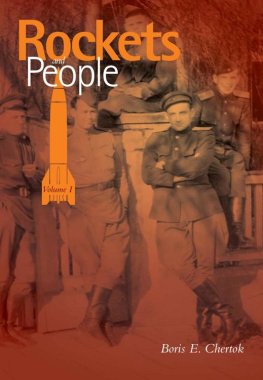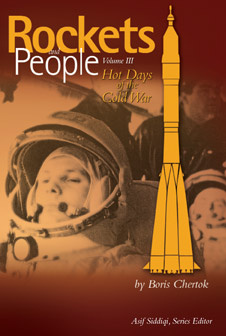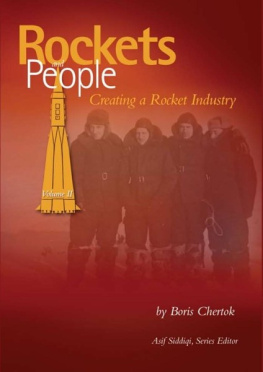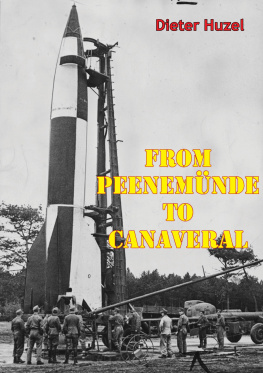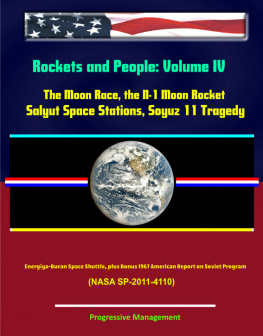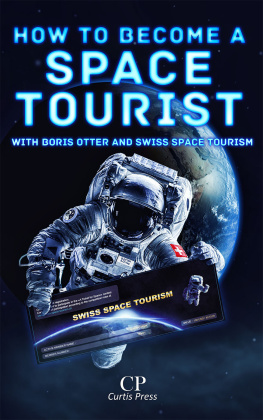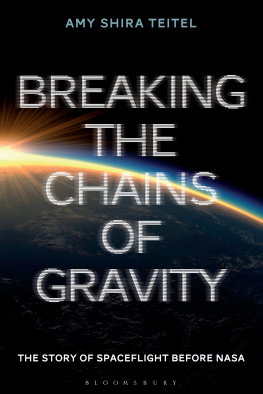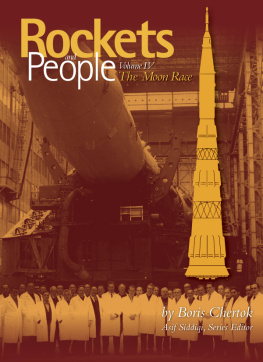Rockets
People
Volume I

Boris E. Chertok
Volume IMuch has been written in the West on the historyof the Soviet space program but few Westernershave read direct first-hand accounts of the menand women who were behind the many Russianaccomplishments in exploring space.The memoirsof Academician Boris Chertok, translated from theoriginal Russian, fills that gap.
Chertok began his career as an electrician in 1930at an aviation factory near Moscow.Twenty-sevenyears later, he became deputy to the founding figureof the Soviet space program, the mysterious ChiefDesigner Sergey Korolev. Chertoks sixty-year-longcareer and the many successes and failures of theSoviet space program constitute the core of hismemoirs, Rockets and People. In these writings, spreadover four volumes, Academician Chertok not onlydescribes and remembers, but also elicits and extractsprofound insights from an epic story about a societysquest to explore the cosmos.
In Volume 1, Chertok describes his early years asan engineer and ends with the mission to Germanyafter the end of World War II when the Sovietscaptured Nazi missile technology and expertise.Volume 2 takes up the story with the developmentof the worlds first intercontinental ballistic missile(ICBM) and ends with the launch of Sputnik andthe early Moon probes. In Volume 3, Chertok recollects the great successes of the Soviet space programin the 1960s including the launch of the worlds firstspace voyager Yuriy Gagarin as well as many eventsconnected with the Cold War. Finally, in Volume 4,Chertok meditates at length on the massive Sovietlunar project designed to beat the Americans to theMoon in the 1960s, ending with his remembrancesof the Energiya-Buran project.
Cover photo
Standing (from right to left): Major B. Chertok, Major Musatov, ColonelN. Pilyugin, and officers of the Seventy-fifth Guards DivisionBleicherode, Germany, 1945. From the authors archives.
Volume IBoris Chertok
The NASA History SeriesNational Aeronautics and Space Administration NASA History Office
Office of External Relations
Washington, DC
January 2005
NASA SP-2005-4110
Library of Congress Cataloging-in-Publication Data
Chertok, B. E. (Boris Evseevich), 1912
[Rakety i lyudi. English]
Rockets and people / by Boris E. Chertok ; [edited by] Asif A. Siddiqi.p. cm. (NASA History Series) (NASA SP-2005-4110)
Includes bibliographical references and index.
1. Chertok, B. E. (Boris Evseevich), 1912 2. AstronauticsSoviet UnionBiography.3. Aerospace engineersSoviet UnionBiography.4. AstronauticsSoviet UnionHistory.
I. Siddiqi, Asif A., 1966 II.Title.III. Series.IV. SP-2005-4110.TL789.85.C48C4813 2004
629.1092dc22
2004020825
I dedicate this book
to the cherished memory
of my wife and friend,
Yekaterina Semyonova Golubkina.
Contents
Series Introduction by Asif A. Siddiqiix
Foreword by Lt. Gen.Thomas P. Stafford, USAF (Ret.)xxiPreface to the English Language Editionxxiii
A Few Notes about Transliteration and TranslationxxvList of Abbreviationsxxvii
vii
In an extraordinary century, Academician Boris Yevseyevich Chertoklived an extraordinary life. He witnessed and participated in many important technological milestones of the twentieth century, and in these volumes, he recollectsthem with clarity, humanity, and humility. Chertok began his career as an electrician in 1930 at an aviation factory near Moscow.Thirty years later, he was one ofthe senior designers in charge of the Soviet Unions crowning achievement as aspace power: the launch of Yuriy Gagarin, the worlds first space voyager. Chertokssixty-year-long career, punctuated by the extraordinary accomplishments of bothSputnik and Gagarin, and continuing to the many successes and failures of theSoviet space program, constitutes the core of his memoirs, Rockets and People.Inthese four volumes, Academician Chertok not only describes and remembers, butalso elicits and extracts profound insights from an epic story about a societys questto explore the cosmos.
Academician Chertoks memoirs, forged from experience in the Cold War,provide a compelling perspective into a past that is indispensable to understandingthe present relationship between the American and Russian space programs. Fromthe end of the World War II to the present day, the missile and space efforts of theUnited States and the Soviet Union (and now, Russia) have been inextricablylinked. As such, although Chertoks work focuses exclusively on Soviet programsto explore space, it also prompts us to reconsider the entire history of spaceflight,both Russian and American.
Chertoks narrative underlines how, from the beginning of the Cold War, therocketry projects of the two nations evolved in independent but parallel paths.Chertoks first-hand recollections of the extraordinary Soviet efforts to collect,catalog, and reproduce German rocket technology after World War II provide aparallel view to what historian John Gimbel has called the Western exploitationand plunder of German technology after the war.1 Chertok describes how theSoviet design team under the famous Chief Designer Sergey Pavlovich Korolevquickly outgrew German missile technology. By the late 1950s, his team producedthe majestic R-7, the worlds first intercontinental ballistic missile. Using thisrocket, the Soviet Union launched the first Sputnik satellite on 4 October 1957from a launch site in remote central Asia.
1. John Gimbel,
Science, Technology, and Reparations: Exploitation and Plunder in Postwar Germany (Stanford:Stanford University Press, 1990).
The early Soviet accomplishments in space exploration, particularly the launchof Sputnik in 1957 and the remarkable flight of Yuriy Gagarin in 1961, werebenchmarks of the Cold War. Spurred by the Soviet successes, the United Statesformed a governmental agency, the National Aeronautics and Space Administration (NASA), to conduct civilian space exploration. As a result of Gagarinstriumphant flight, in 1961, the Kennedy Administration charged NASA to achievethe goal of landing a man on the Moon and returning him safely to the Earthbefore the end of the decade.2 Such an achievement would demonstrate American supremacy in the arena of spaceflight at a time when both American andSoviet politicians believed that victory in space would be tantamount to preeminence on the global stage.The space programs of both countries grew in leaps andbounds in the 1960s, but the Americans crossed the finish line first when Apolloastronauts Neil A. Armstrong and Edwin E.Buzz Aldrin, Jr. disembarked on theMoons surface in July 1969.
Shadowing Apollos success was an absent question:What happened to the Soviets who had succeeded so brilliantly with Sputnik and Gagarin? Unknown to most,the Soviets tried and failed to reach the Moon in a secret program that came tonaught.As a result of that disastrous failure, the Soviet Union pursued a gradual andconsistent space station program in the 1970s and 1980s that eventually led to theMir space station. The Americans developed a reusable space transportation systemknown as the Space Shuttle. Despite their seemingly separate paths, the spaceprograms of the two powers remained dependent on each other for rationale anddirection. When the Soviet Union disintegrated in 1991, cooperation replacedcompetition as the two countries embarked on a joint program to establish the firstpermanent human habitation in space through the International Space Station (ISS).
Academician Chertoks reminiscences are particularly important because heplayed key roles in almost every major milestone of the Soviet missile and spaceprograms, from the beginning of World War II to the dissolution of the SovietUnion in 1991. During the war, he served on the team that developed the SovietUnions first rocket-powered airplane, the BI. In the immediate aftermath of thewar, Chertok, then in his early thirties, played a key role in studying and collecting captured German rocket technology. In the latter days of the Stalinist era, heworked to develop long-range missiles as deputy chief engineer of the mainresearch institute, the NII-88 (pronounced nee-88) near Moscow. In 1956,

